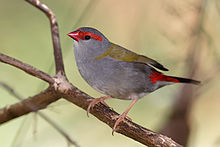
Back شمعية المنقار Arabic شمعية المنقار ARZ Julayek (Estrildidae) AVK Kedis perit BAN Estrildidae Breton Estríldids Catalan Estrildidae CEB Astrildovití Czech Prachtfinken German Estrildedoj Esperanto
| Estrildidae | |
|---|---|

| |
| Red-browed finch, Neochmia temporalis | |
| Scientific classification | |
| Domain: | Eukaryota |
| Kingdom: | Animalia |
| Phylum: | Chordata |
| Class: | Aves |
| Order: | Passeriformes |
| Superfamily: | Passeroidea |
| Family: | Estrildidae Bonaparte, 1850 |
| Genera | |
Estrildidae, or estrildid finches, is a family of small seed-eating passerine birds of the Old World tropics and Australasia. They comprise species commonly known as munias, mannikins, firefinches, parrotfinches and waxbills. Despite the word "finch" being included in the common names of some species, they are not closely related to birds with this name in other families, such as the Fringillidae, Emberizidae or Passerellidae.
They are gregarious and often colonial seed eaters with short, thick, but pointed bills. They are all similar in structure and habits, but vary widely in plumage colours and patterns.
All estrildids build large, domed nests and lay five to ten white eggs. Many species build roost nests. Some of the firefinches and pytilias are hosts to the brood-parasitic indigobirds and whydahs, respectively.
Most are sensitive to cold and require warm, usually tropical, habitats, although a few, such as the eastern alpine mannikin, mountain firetail, red-browed finch, and the genus Stagonopleura, have adapted to the cooler climates of southern Australia and the highlands of New Guinea.
The smallest species of the family is the Shelley's oliveback (Nesocharis shelleyi) at a mere 8.3 cm (3.3 in), although the lightest species is the black-rumped waxbill (Estrilda troglodytes) at 6 g (0.21 oz). The largest species is the Java sparrow (Padda oryzivora) at 17 cm (6.7 in) and 25 g (0.88 oz).[1]